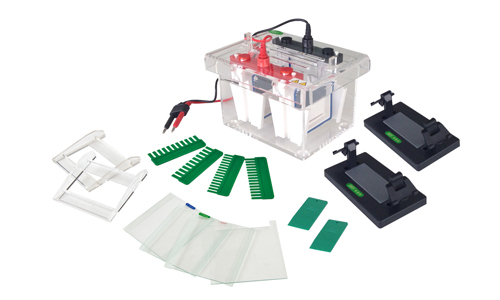This technique is widely used in laboratories, especially in those of molecular biology, because it is used in important procedures such as separation, analysis and purification of RNA, DNA, or proteins, nucleic acids, this process is done because most of the biomolecules have an electric charge where its magnitude depends on the pH of the environment in which they are, because of this the biomolecules move when they undergo an electric field to the charge pole opposite the molecule.
Its operation is a simple process, separates molecules according to their size and electrical charge, for this an electrical current is used that drives to move the molecules through a gel or other matrix., then the pores of the gel act as a screen, allowing smaller molecules move faster than larger molecules, to know the size of the molecules in a sample, are compared to the standards of established sizes that are separated in the same gel.
As occurs of molecule migration in electrophoresis
For proteins that can have a positive or negative charge, they are usually neutral charge, for the migration of molecules pretreatment with detergents, such as sodium dodecyl sulfate (SDS), which gives them a negative charge, this homogenizes the proteins in the sample and all migrate to the positive pole; they will only be separated by size.
Now, on the nucleic acid side, they just have a negative charge, because their phosphate backbone, instead electrophoresis, causes the nucleic acids to migrate to the positive pole, called the anode. This migration technique is what we call the electrophoresis principle, where the displacement of the molecules through a gel or other type of porous matrix is produced proportionally, using the parameters of molecular weight or size; movement generated by the electric field.
Principles of electrophoresis
This principle is based on the techniques used for molecule migration, this process is done in a kind of box which has a positive end charge on one side and a negative charge on the other side, when placed inside a molecule charged inside, it moves following a specific pattern, that is, if the molecules have negative charge they will migrate to the positive charge, but on the contrary if it is charged positively because it moves to the negative side.
When you analyze the proteins in a gel, you take the whole protein to see how big it is, and you do the next principle: the shorter the protein, the more it migrates into the gel, so that the small proteins will end up at the bottom of the gel, because they’ve gone farther, and the larger proteins will end up staying at the top. But in the case of DNA, we work with a very long molecule, so scientists choose to cut the DNA with things like restriction enzymes, making the DNA more manageable into smaller pieces, then depending on how big they are, they migrate more or less up the gel and end up higher or lower.
Elements necessary for an electrophoresis
Electrophoresis requires a series of elements, such as: electrophoresis chamber, well combs, gel, transilluminator, power source, current buffer, molecular weight marker, charge buffer. It is important to note that the chambers of vertical electrophoresis the positive pole is located at the bottom of the chamber and in the horizontal chambers, at one end. For both types of cameras, the positive pole is identified as red, and the negative pole is identified as black.
If you want to buy electrophoresis equipment and you are in doubt of which model best suits the needs of the research center, please consider contacting the best, this service we can offer you through our online channels and at the best price of the market, also if you want to know the catalog of high-end products that Kalstein have for you visit us HERE We assure you that through our online purchasing channels that are very easy and viable from anywhere in the world, reminding you that we are a company manufacturer of high level laboratory equipment for sale. HERE

